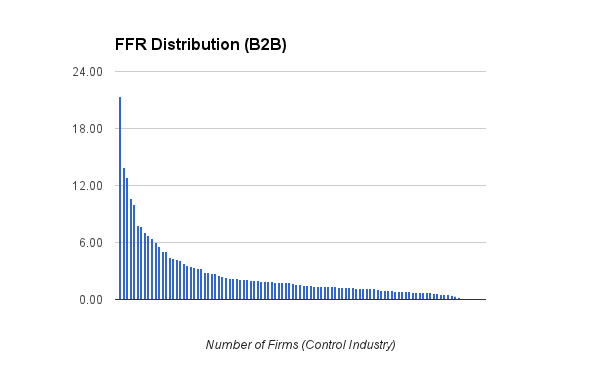By Steve Baldwin | March 13, 2014
 OK – so you’ve got some followers on Twitter, and now you want to get some more, so you’ll likely do some following yourself. After all, some small share of the folks you follow will eventually follow you back, right? Shouldn’t you just go follow everything you can find? Well, no. Unless you have a huge pre-existing following, you can’t afford to follow too many people, because it can make you look, well, a bit sad (and looking sad on Social Media is the last thing any brand wants to do).
OK – so you’ve got some followers on Twitter, and now you want to get some more, so you’ll likely do some following yourself. After all, some small share of the folks you follow will eventually follow you back, right? Shouldn’t you just go follow everything you can find? Well, no. Unless you have a huge pre-existing following, you can’t afford to follow too many people, because it can make you look, well, a bit sad (and looking sad on Social Media is the last thing any brand wants to do).
Introducing FFR: A Tool For Measuring Brand Exclusivity on Twitter
This is where your Twitter FFR (Follower to Followed Ratio) becomes a useful metric. FFR is s easy to compute: just take your Twitter Followers, and divide them by the number of people or brands your Follow.
For example:
Number of Followers: 1,000
Number of Followed: 500
FF Ratio = 1000/500 = 2.0
FFR is a rough but meaningful approximation of how exclusive or inclusive any given brand is on Twitter. It doesn’t measure overall Twitter “footprint” or overall influence: only the degree to which your brand’s followers are rewarded with follows in return. Think of FFR as measuring your brand’s “Twitter posture” — or general willingness to reciprocate affection from those who like you.
How high should your brand’s FFR be? Well, that’s up to you. How “accessible” do you want to appear to be? How exclusive? For example, Lady Gaga’s FFR is 304.4 — about as exclusive as you can get. Justin Bieber’s is even higher (402.4). Among consumer brands, FFRs are generally orders of magnitude lower (but still respectable). Coca-Cola’s is 34.6; Pepsi’s is 57.11; Starbucks is 67.27, RadioShack’s is 25.2.
FFR in a B2B Context
B2B FFRs tend to trend lower than B2B brands (and far below celebrities). We sampled a control group of 100 B2B firms – each of which had a Twitter presence and an active link from their home pages, to get an initial idea of how FF Ratio may be distributed in a B2B space. While every industry is different, we can see that FF Ratio appears to be distributed in a classic Long Tail Distribution curve.
For our group of 100 sample firms, the industry average FFR score was 2.23. The vast majority of firms in this business category had FFRs under 3; only handful had FFRs above 10. Note that most firms in this industry – the vast majority – had good FFRs in the 2 to 4 range – perhaps low enough for one to expect a reasonable reciprocity rate. Obviously, this information can be highly useful when determining who to approach in a Twitter organic audience-building campaign.

Using FFR in Your Social Media Marketing Plan
Where FFR gets really useful is when you – on behalf of yourself or your brand – are trying to build an audience by specifically targeting players in your own industry. Using FFR can steer your efforts towards brands and individuals with respectable, but not superlative audiences, whose chances of returning your Follow in kind are higher than others. Doing so can make your Twitter efforts more efficient, and also reduce the chance that your own FFR will drop too much (the subject of the next section).
Should you waste time trying to become a chum with an impossible-to-reach Twitter star or focus your efforts in the “Long Tail” of people and brands more likely to respond? Ideally, you’ll need to target both kinds of people, but if your resources are limited, use FFR to target lower-value, but higher-likelihood responders.
You don’t have to be a slave to your FFR – it’s just a useful benchmark whose value is decided by you. Sometimes, for example, when you’re involved in aggressive Twitter audience building efforts, your FF Ratio might drop far below your benchmark – but nobody’s going to penalize you for this. As long as you keep your FFR above 1.0, you won’t look like a loser. In fact, having a low FFR might actually benefit — if your business is in selling social media services. Most social media influencers have very low FFRs ( a few even have negative FFRs), and that’s good for them: it shows folks who want to engage with them that they’ll likely engage back.
It’s best to keep your eye on your FFR on a weekly basis – if you see it going out of whack, purge those people you followed who didn’t follow you back. There are many helpful “unfollowing” tools that can help you maintain an ideal FFR, either as desktop applications or mobile apps.
Have a question about data, social media analytics, or trend research? Get in touch with Didit.
- 10 Mistakes to Avoid When Using QR Codes for Marketing - September 20, 2023
- Kevin Lee on How AI Changes the SEO Landscape - August 31, 2023
- The Power of Compound Marketing: Kevin Lee Presents @ 1MediaWorld 2023 Global Conference - March 7, 2023
